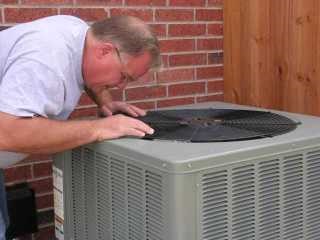The outside fan is responsible for removing heat from the refrigerant so it can return as a cooled liquid to the inside unit and start the loop all over again. The outside “condenser fan” should be  running any time the unit is cooling. You can go outside and check the fan in the condensing unit for proper operation when it’s running.
running any time the unit is cooling. You can go outside and check the fan in the condensing unit for proper operation when it’s running.
Be certain your thermostat is turned to the cooling position and the temperature is set low to bring the unit on. You should hear and feel air movement through the inside unit and duct in the house. (If not you may have a system-wide problem that is preventing both inside and outside units from working).
Once running, go to the outside condensing unit and check things out. There are several possible conditions you can observe:
- If the unit seems to be hot but the fan is not running, there is likely an electrical or mechanical problem with the fan motor itself. While you cannot typically touch the compressor with the covers on the cabinet, you can tell if the unit seems hot but not running. Feeling the grill above the compressor or the sides of the condensing unit will give you clues. You may hear the compressor come on for 10-30 seconds and then shut down for 6-10 minutes before cycling again. The cycling is the thermal protector on the compressor which is overheating without the fan. You will likely need a qualified technician to service the unit.
- If the fan is running but the air being ejected from the unit is not hot and the compressor is not running, there is likely a mechanical or electrical problem that is keeping the compressor from running. The clue is that the unit does not seem to be any warmer than the outside air and the air being discharged from the top is not warmer than the outside temperature. This is not likely a fan failure, but some other problem. You will likely need a qualified technician to service the unit.
- It the outside unit seems to be totally dead, no fan is running, no compressor is running, and the unit feels cool to the touch, there may be a general electrical failure. Before calling for service, recheck the thermostat settings to be certain they are in the cooling position. Also check your breaker panel for tripped breakers. (Tripped breakers are common following a short power glitch or blackout during a storm.) Typically there are two breakers per AC unit. One is for the inside unit and one for the outside unit. Be certain to check them both.
The cause of an overheated condenser unit could be from several causes. A defective fan motor is the most common. However, the problem could also be related to an electrical problem or even really low or lost refrigerant. Except for resetting tripped breakers, repairs will often require a qualified NATE technician.